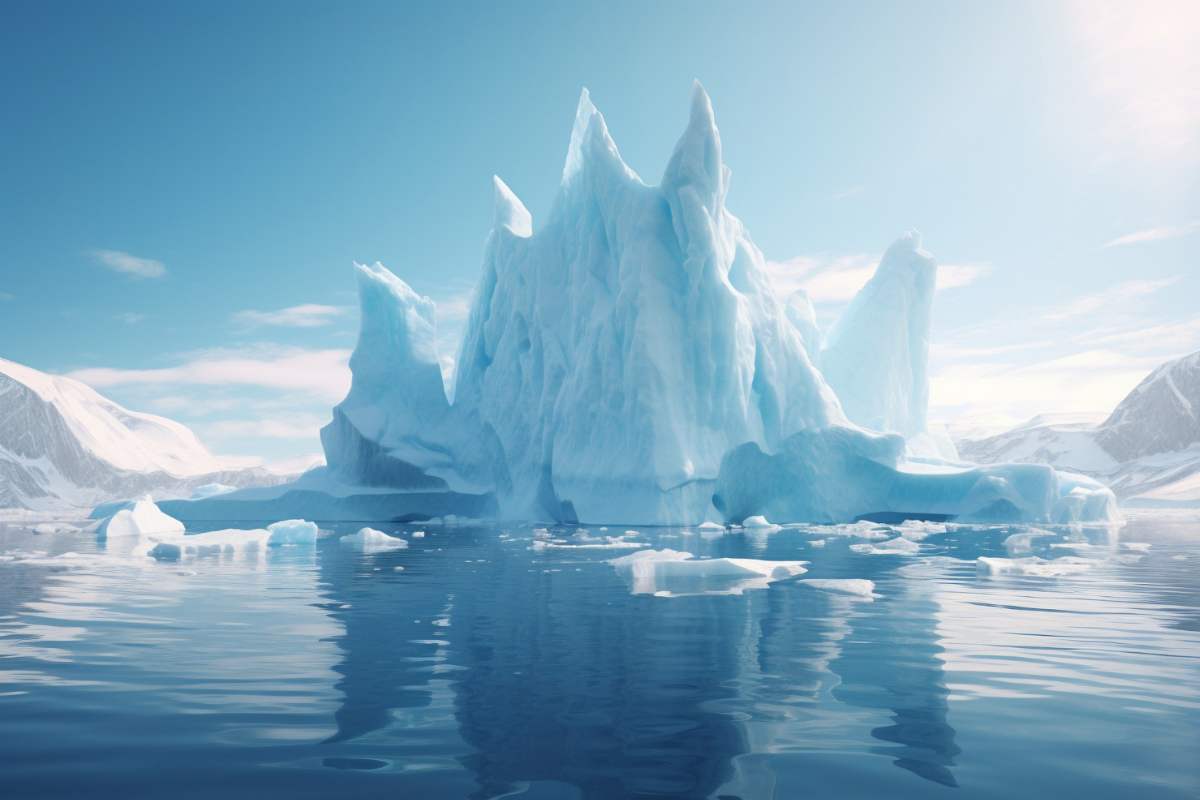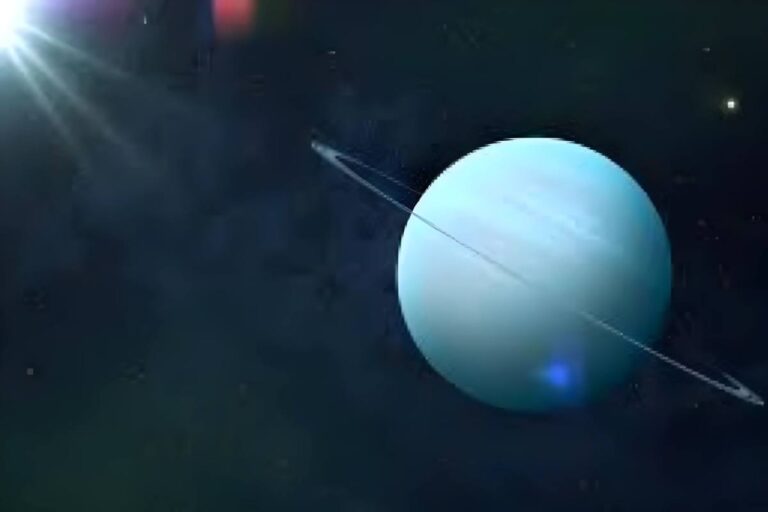The Earth, a planet that appears to be stable, is experiencing changes at its very extremities that have left scientists in awe. A dramatic change at Earth’s North and South Poles has been witnessed, with recent discoveries showing shifts of a magnitude that exceeds the geological effects of ice ages. These cinematic changes, caused mainly by the mounting impacts of global warming, are not remote scientific abstractions; they have real-world ramifications for our technology, world climate patterns, and the sensitive web of ecosystems throughout the globe.
The reason scientists are astonished is that a recent, broad study was published in the prestigious journal Geophysical Research Letters. This study, carried out by researchers at ETH Zurich, explored the details of polar motion, examining data from 1900 to 2018. By combining this past data with predictions of future ice melting in different climate change scenarios, the scientists revealed a potentially large displacement of Earth’s geographic poles toward the end of the 21st century.
Their findings suggest that under a worst-case scenario of greenhouse gas emissions, the North and South Poles could shift by an astonishing 89 feet (27 meters) by the year 2100. Even under a more optimistic emissions trajectory, a substantial shift of approximately 39 feet (12 meters) is still anticipated. To put this into context, scientists have known for centuries that the Earth’s crust is still rebounding from the massive weight of ice age glaciers that melted out thousands of years ago, a phenomenon referred to as Glacial Isostatic Adjustment (GIA).
This process of Earth’s surface rebound results in minute changes in mass distribution and, as a result, the location of the poles. But as study co-author Mostafa Kiani Shahvandi, an Earth scientist currently at the University of Vienna, noted, the changes caused by human activities are “somewhat surpassing the effect of glacial isostatic adjustment”. The comparison highlights the dramatic effect that human activities are now exerting on the physical geography of our world.
Big Change at Earth’s North and South Poles Explained by Climate Change.
The key engine driving this major change at Earth’s North and South Poles is the record-breaking loss of ice sheet and glacier mass around the world. As the planet warms, these giant reservoirs of water that are frozen become ever more rapidly losing mass, and that causes a large redistribution of water on the planet. This meltwater moves into the ocean and, in effect, is moving mass from the high-latitude polar regions toward the equator.
The study specifically found that meltwater from the Greenland and Antarctic ice sheets had the most significant effect on this polar shift, with the melting of glaciers in other parts also exerting a major influence. This mass redistribution results in the Earth slightly wobbling on its axis, a process referred to as “polar motion” or “polar wander.”. NASA-sponsored research has also shed further light on this relationship, illustrating a definitive relationship between global warming-induced ice melting and changes in Earth’s rotation and shifting of its poles.
The physics behind it is like a spinning top; the top’s spin is reduced when weight is transferred from the center to the periphery. Likewise, moving mass from the poles to the equator through melting ice results in a slight slowing down of Earth’s rotation, leading to a tiny but quantifiable lengthening of our days. Indeed, since the year 2000, the rate at which our days are lengthening has been rising, directly due to the increased melting of ice sheets caused by human-induced greenhouse gas emissions.
Effect on Navigation and Technology
This continuous change in the Earth’s rotation axis has profound implications for technologies that depend on accurate positioning, particularly satellite and spacecraft navigation. Scientists use the Earth’s rotation axis as a basic reference when charting the positions and paths of spacecraft.
As this axis shifts, it creates the possibility of inaccuracy in these calculations, which would result in malfunctions in GPS systems and other navigation equipment. Even relatively small changes to the Earth’s axis can add up over large distances and create huge navigation errors. For instance, the use of old models of the Earth’s rotational axis could send a spacecraft or even a commercial flight off course.
As a result, space agencies and bodies charged with the upkeep of global navigation systems might be required to monitor and update their procedures constantly to keep up with these constant polar shifts. Distinguish this shift of the geographic poles from the distinct phenomenon of the moving magnetic north pole, which impacts compass navigation and will be addressed in the next section.
The Magnetic North Pole’s Separate Journey
Although the geographic poles are determined by the axis of rotation of the Earth, the magnetic north pole tracks a distinct, though similar, route. The magnetic north pole is that point on the surface of the Earth at which the magnetic field lines of the planet intersect, and where it is not the stationary location of the geographic North Pole. Over several decades, the magnetic north pole has been found to wander through the Arctic area in the direction of Siberia.
This movement has even exhibited phases of acceleration and, more recently, deceleration.
The force behind the magnetic pole’s wanderings is deep within the Earth’s outer core, where the agitation of molten iron and nickel creates the planet’s magnetic field – a process referred to as the geodynamo.
As the dynamics of this molten core shift, so too does the position of the magnetic north pole. To provide certainty for magnetic-dependent navigation systems like compasses, aviation, and shipping, researchers from Britain and America together produce and continuously revise the World Magnetic Model (WMM). This model describes where the north magnetic pole is located and is vital for different technologies, like certain GPS devices. The continuing migration of the magnetic pole means that these revisions have to happen from time to time to avoid navigational mistakes.
Within the global context of the Earth’s magnetic field, there has also been a reported progressive weakening of the overall strength of the field itself over the last two centuries or so. The weakening has contributed to speculation concerning a possible eventual geomagnetic reversal, whereby the north and south magnetic poles switch positions. The current state of scientific knowledge would indicate, however, that no such reversal can be anticipated anytime soon.
Unusual Temperature Patterns and the Polar Vortex
To add to the complexity of the changes occurring at Earth’s poles are the unusual temperature patterns witnessed in recent times. Most particularly, scientists have been worried by the coexistence of unprecedentedly high temperatures in the Arctic and Antarctic regions simultaneously. In March 2024, for example, weather stations in Antarctica measured temperatures reaching 40 degrees Celsius above the average for the season, while temperatures in some parts of the Arctic were more than 30 degrees Celsius above their average. This concurrent extreme heat at both poles, which are in opposite seasons, is an extremely rare occurrence that has alarmed climate scientists.
These temperature fluctuations are directly connected to the activity of the polar vortex, a band of powerful westerly winds that develops high in the atmosphere around both the North and South Poles, encircling a huge reservoir of cold air inside. Climate change, notably the increased warming that has been seen in the Arctic, has been shown to weaken and destabilize this polar vortex. When the vortex is weakened at the jet stream, it may become wavier and permit extremely cold Arctic air to extend further southward into the mid-latitudes, resulting in intense cold snaps.
On the other hand, the disruption of the jet stream may also permit warmer air to extend further northward into the Arctic. The “sudden stratospheric warming,” a sudden increase in temperature in the stratosphere, can also make significant contributions to the stability and behavior of the polar vortex. Although both poles have a vortex, their behavior differs, with the Antarctic vortex usually being more stable compared to the Arctic one.
Shifting Ocean Currents: A Great Change.
Another huge change is being caused by the melting of polar ice, and it’s not just changing the land and atmosphere. It is greatly influencing the world’s great ocean currents. One such concern is the possible weakening of the Atlantic Meridional Overturning Circulation (AMOC), a vital system of ocean currents that encompasses the Gulf Stream.
The flow of vast quantities of freshwater from melting Arctic ice could disturb the sensitive balance of salinity and temperature that powers the AMOC, potentially causing it to weaken. In the same way, Antarctic ice melting is expected to lead to a deceleration of the Antarctic Circumpolar Current (ACC), the Earth’s fastest ocean current. The powerful current plays a crucial role in maintaining the global climate by transferring heat, carbon dioxide, and nutrients around the globe.
Weakness in the ACC could have terrible impacts, which range from the intensification of climate variability to increased and amplified extreme weather patterns, faster global warming through diminishing ocean capacity for carbon dioxide capture, and the profound disruption of marine ecosystems.
These oceanic changes are mainly caused by the modification of ocean salinity and density due to the huge input of comparatively fresh meltwater into the salty polar oceans.
Long-term Perspectives and Future Projections
Polar ice loss and warming trends project a dismal image for the future. Scientific observations unambiguously point towards an increase in these changes over the last few decades. Predictions indicate that the greatest change at Earth’s North and South Poles will persist throughout the 21st century, with the size of the shift varying with future greenhouse gas emission scenarios.
A concern is developing that if certain key thresholds, or tipping points, are crossed, the pace of ice loss may become increasingly fast and potentially irreversible on human timescales. It is worth pointing out that over very long geological timescales, the Earth’s poles have naturally moved, a phenomenon referred to as true polar wander. But the present changes are happening at a much more accelerated pace and are immediately connected with human-caused climate change, in contrast to the slow, natural movement of the past.
The scientific consensus is that, if the trends continue, the polar shift caused by climate change will ultimately outpace the natural, post-ice age recovery of the Earth’s crust as the determining force on the planet’s rotational axis.
Global Environmental and Ecological Impacts
The effects of polar ice melting reach far beyond mere shifting poles and affect the global environment and ecosystems in many ways. The most direct and obvious impact is sea level rise, which poses a threat to coastal communities and ecosystems across the globe with heightened flooding, erosion, and storm surges. Another very important factor is the ice-albedo feedback mechanism. Ice and snow are very reflective, reflecting solar radiation into space and acting to regulate global temperatures. As this ice melts, the more absorbent darker ocean or land surfaces take up more sunlight, causing further warming and speeding the melting process along.
The effects on Arctic and Antarctic wildlife are especially dire, with numerous species such as polar bears, walruses, seals, and penguins being threatened by loss of habitat and access to their food sources due to the melting sea ice. Also, thawing of Arctic permafrost unleashes enormous quantities of methane, a very potent greenhouse gas, and contributes further to global warming.
The disruption of weather patterns and ocean currents, as mentioned above, is another very major global effect. Although some research indicates possible short-term ecological benefits locally due to nutrient release from ice melting, these have been deemed transient and are outweighed by the tremendous negative impacts on a global level.
International Efforts to Monitor Polar Changes
Alarmed by the drastic and long-term implications of such polar changes, the global scientific community has set up many collaborations to monitor and research these key areas. Institutions like the Arctic Council are important in enabling international cooperation regarding Arctic problems, including the effects of climate change.
Space agencies like NASA and ESA employ advanced satellite missions, such as GRACE and GRACE Follow-On, to accurately monitor ice mass loss in Greenland and Antarctica and to monitor the slight polar motion of the Earth’s poles. The World Meteorological Organization (WMO) provides international coordination of efforts to enhance weather and climate information for the polar regions. International research projects, including the Ice Sheet Mass Balance Inter-comparison Exercise (IMBIE), unite scientists globally to produce comprehensive reports of ice sheet mass change. Also, projects like the Distributed Biological Observatory (DBO) provide an example of international cooperation in monitoring the ecological processes taking place in the Arctic Ocean.
These joint endeavors highlight the value of data sharing, efficient use of research infrastructure, and long-term financing to support the vital work of understanding and addressing the swift changes occurring at Earth’s poles.
Conclusion
The scientific observations are unequivocal: a dramatic change at Earth’s North and South Poles is underway, fueled by the unrelenting power of human-induced climate change.
Not only is ice sheet and glacier melting inducing a massive change in the Earth’s axis of rotation, outpacing the effects of previous ice ages, but it is also inducing a chain reaction of consequences that affect our technology, worldwide climate patterns, and the intricate balance of ecosystems across the globe. From potential disruptions to satellite navigation to the intensification of extreme weather events and the loss of critical wildlife habitats, the changes happening at the poles are a grim reminder of the deep impact that human activity is having on our world.
To overcome this hurdle calls for coordinated global action against greenhouse gas emissions and a push towards a clean future so that the phenomenal developments witnessed at Earth’s ends may not cause irreparable havoc in nature for the whole world.






















Very detailed and informational
Yes
yes
It is really concerning 😟
You are right
nice article